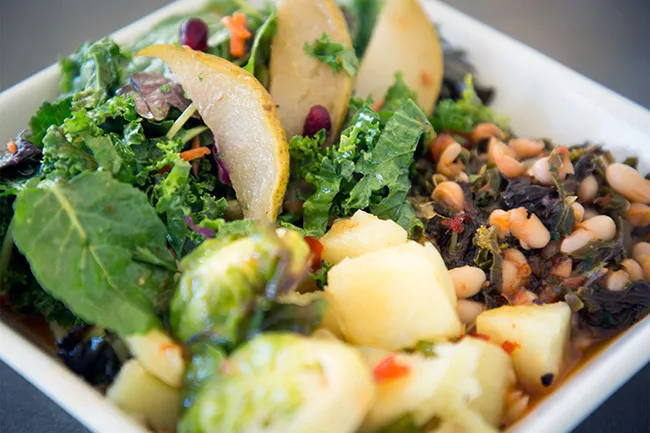Hospital food isn’t known for tasting good or even being all that good for you. But some U.S. hospitals are teaming up with farms to change that.
You probably think of hospital food as premade, prepackaged, bland, and colorless — except for the Jell-O, of course. Maybe you’ve brought a friend or relative soup or a sandwich to their hospital room because the place where you most expect a healthy meal is one of the places you’re least likely to get it.
So you might be surprised to know that some hospitals are teaming up with local farms to offer healthier, tastier food. A few even have their own farm on campus.
“Good food is good medicine,” says Santana Diaz, executive chef of food and nutrition services of UC Davis Medical Center in Davis, CA, and the first U.S.-born person in his family of generations of Mexican farmers.
“Patients are at the center of everything we do,” Diaz says. “I know I’m not a doctor or a nurse standing next to the patient, but I want to give everyone in our care the healthiest choices possible.”
Diaz and others are proving it’s possible to provide healthy meals for patients and help local growers at the same time.
Diaz and his team serve 1,530 patient meals a day and more than 4,000 meals in retail spaces.
Diaz puts his “boots on the ground of every farm we buy from to make sure it’s a real place,” then uses a local distributor for pick up and delivery.
“We get two pallets of produce every day. That’s about 2,000 pounds, or 1 ton,” Diaz says. “When we say we go through a ton of produce a day, we literally mean a ton of produce a day.”
This translates to local tomatoes in salads, local peaches for dessert, and black beans that become a fiber-filled side for taco Tuesday, and a black bean vinaigrette that keeps sugar levels in salad dressing low but the flavor profile high.
It’s also good for the farmers. With a large-scale operation, Diaz can forecast with farmers what his yields and needs are for the year or even years ahead.
“Farmers and ranchers who don’t have a buyer on the backend take all the risk,” Diaz says. “Say a farmer plants asparagus. It’s not something that just pops up in a few months. When it’s ready, asparagus is labor intensive — you have to cut it by hand. Then farmers have to compete with other markets. By the harvest, it may be worth less than it took to produce because of commodity pricing. Then maybe they don’t plant asparagus again the following year.”
“When we can tell a local grower, ‘This is what we need for asparagus next year,’ we’ve eliminated the risk for the farmer because now they know they have a buyer and know what they’re going to yield per acre,” Diaz says. “And we’ve preserved that crop in the region.”
More than half of the produce that John Muir Medical Centers serves to patients and visitors — 60% — comes from California. And 50% of that comes from farms within a 150-mile radius.
That’s possible thanks to their partnership with Bay Cities Produce Co. While Joe LaVilla, the culinary operations manager of nutrition services for John Muir, focuses on the meals, Bay Cities vets and works with local farms to make sure the necessary but less sexy side of food procurement — federally regulated standards like food safety, fair trade and field, soil and water testing — is up to speed.
“Hospitals don’t want people getting sick,” says Steve del Masso, president of Bay Cities Produce Co. “John Muir has the desire to do the right thing with small farms, and they’re dedicated to keeping local going. At the same time, there are food safety concerns. I think we’re a good go-between.”
For patients, this means the stir-fried vegetables or carrots in the carrot-ginger soup come fresh from farms, not out of freezer bags.
“Our overnight oats for breakfast feature local blood oranges. We serve local squashes, Brentwood corn in season, and up to four special salads a day — all based on what’s fresh and local,” DaVilla says. “Our best seller is a steak salad with arugula, endive, peppers, frisee, and shaved onion.”
Built on a former golf course, Lankenau Medical Center’s 98-acre campus includes a 2-acre farm right across the street from the emergency room.
Since 2016, the Deaver Wellness Farm has produced more than 13,000 pounds of onions, greens, tomatoes, melons, beans, and peas.
“Anything you can grow, we grow,” says Phil Robinson, president of Lankenau Medical Center.
Education is a big part of the programming. School children visit the farm to learn about food that doesn’t come out of a wrapper or bag. Patients with food insecurity — those who don’t have access to fresh fruits and vegetables — talk with a dietitian about produce and recipes. Then they get fresh fruits and vegetables delivered to their homes.
“If you just patch them up and send them back where they came from, you’re not doing a lot of good,” Robinson says. “If we’re really going to make a difference and improve our patients’ health status, it has to be outside the four walls of this hospital.”
All 3,000-plus pounds of produce harvested from The Sky Farm at Eskenazi Health every year make their way into free food and nutrition classes. This helps patients at all Eskenazi locations — especially those with diabetes, heart disease, and other chronic diseases — learn how to control and even reverse their conditions.
Class topics include “Lifestyle Medicine,” “Growing Strong: Cooking Matters,” “Fresh Veggie Fridays,” and “What Can I Eat?”
Squash, peppers, tomatoes, eggplant, cucumbers, radishes, and herbs are just a few of the crops that grow on Boston Medical Center’s rooftop farm every year.
More than 5,000 pounds of food from the farm is used in hospital cafeterias, patient meals, demonstration kitchens, and the center’s preventive food pantry, which supplies nutritious food to those who can’t afford it.
The micro-farm on the third floor deck of the Health Science Center at Stony Brook Medicine has more than 2,000 square feet of gardening space that yields fresh fruits and vegetables used in patient meals.
Their “farm-to-bedside” concept often includes a tent card on the tray to let patients know some of their meal was harvested at the farm.
Through a partnership with the Rodale Institute, St. Luke’s University Health Network has St. Luke’s-Rodale Institute Organic Farm, 8 acres of crops that supply all 12 hospitals in their network with 100 varieties of chemical-free, certified organic produce.
Everything from salad greens, broccoli, and peppers to Swiss chard, garlic, beets, and herbs is incorporated into patient, visitor, and staff meals, and is available for purchase at on-site farmers markets at various hospital locations.








